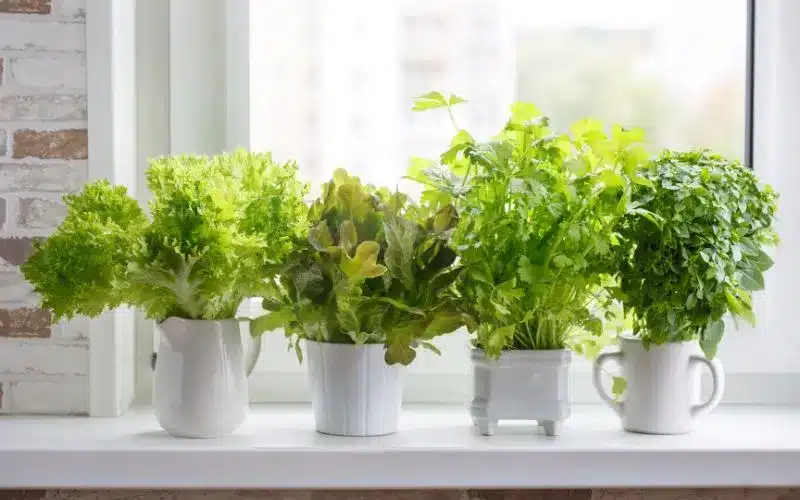
City life rarely comes with garden space, yet you can still enjoy a steady supply of fresh herbs at home. Thanks to Herb Hydroponics, you can ditch the soil altogether and grow vibrant greens in even the smallest studio. This soilless, water-based system is smart, mess-free, and tailor-made for tight quarters, turning a single shelf or windowsill into a flourishing mini-farm.
In this guide, you’ll learn everything from selecting a compact hydroponic kit and proper lighting to choosing herb varieties that thrive in confined spots. With Herb Hydroponics, you’ll discover just how effortless—and satisfying—urban gardening can be.
Let’s get started.
Hydroponics is a method of growing plants using a water-based nutrient solution instead of soil. The roots sit in this nutrient-rich liquid or are supported by an inert medium like coco coir, perlite, or clay pebbles, depending on the system.
So why does this matter for you?
Because hydroponics removes the bulkiness and mess of soil, letting you grow fresh herbs like basil and mint right on your kitchen counter or balcony. Unlike traditional gardening, hydroponics:
Requires 80-90% less water
Eliminates weeding entirely
Allows you to control nutrient levels and pH precisely
Speeds up plant growth by up to 50%, according to studies from NASA
In a studio apartment, every square inch counts. That’s where hydroponics really shines. Here are key advantages:
| Benefit | Why It Matters |
|---|---|
| Space Efficiency | Compact, vertical designs let you grow upwards, not outwards |
| Cleaner Setup | No soil = no mess or pests indoors |
| Year-Round Gardening | Controlled indoor environments mean fresh herbs in every season |
| Fast Growth | Nutrients go straight to the root, speeding up development |
| Customizable | You can scale it from a mason jar to a full vertical garden wall |
Some herbs do better than others in a hydroponic setup. Here are your hydroponic heroes:
Basil – Thrives in warm, humid conditions. Grows fast and tastes amazing fresh.
Mint – Almost impossible to kill. Great in teas and cocktails.
Parsley – Takes time to germinate, but gives you months of harvest.
Chives – Great for garnishes and spreads. Doesn’t need much space.
Thyme – Low-maintenance and perfect for savory dishes.
Cilantro – Fast-growing but sensitive—great for adventurous gardeners.
| Herb | Days to Germinate | Ideal pH | Harvest Tips |
|---|---|---|---|
| Basil | 5–10 | 5.5–6.5 | Pinch tops to prevent flowering |
| Mint | 10–15 | 6.0–7.0 | Trim often to keep it bushy |
| Parsley | 14–21 | 6.0–7.0 | Snip from the outside, not the center |
| Chives | 7–14 | 6.0–7.0 | Cut back to about 1″ above soil line |
| Thyme | 14–28 | 5.5–7.0 | Prune regularly for better flavor |
| Cilantro | 7–10 | 6.2–6.8 | Harvest before bolting starts |
Pro Tip: Use a TDS meter and pH tester to keep your water chemistry in check. It makes a massive difference.
Here’s a quick overview of beginner-friendly systems you can try in your indoor or balcony setup:
Kratky Method Jars – No pumps or electricity. Just a container, water, and a plant.
Deep Water Culture (DWC) Buckets – Great for one or two herbs. Needs air stones and pump.
Countertop Hydroponic Kits – Think AeroGarden. Sleek, self-contained, and beginner-friendly.
Vertical Towers – Best for serious growers. Stack multiple herbs in a single vertical unit.
| System | Pros | Cons |
|---|---|---|
| Kratky | Cheap, DIY-friendly | Limited to short-term growth |
| DWC | Fast growth, reusable | Requires electricity and maintenance |
| Countertop Kits | Aesthetic, easy to use | Costly, less flexible |
| Vertical Towers | Space-efficient, high yield | Higher upfront cost, needs planning |
For a DIY approach, check out guides on Instructables to create your own planter using plastic bottles or storage bins.
Vertical hydroponic gardens are trending, and for good reason:
You grow more in less space
Makes use of blank walls, balconies, and corners
Helps keep herbs off ground, reducing contamination risks
If you’re living in a high-rise or a studio, vertical setups are game-changing.
There are two ways to go vertical:
DIY approach: Stack recycled containers with drip systems. Use materials like PVC pipes, net cups, and a small water pump.
Modular towers: Buy stackable hydroponic towers from brands like Mr. Stacky or Tower Garden.
Safety Tip: Secure vertical gardens to walls or stands to prevent tipping, especially if pets or children are around.
Herbs crave sunlight. But when you’re indoors, natural light might not cut it.
That’s where LED growlights come in. They’re energy-efficient, long-lasting, and come in compact sizes.
| Type | Pros | Cons |
|---|---|---|
| LED | Low heat, low power, full spectrum | Slightly more expensive |
| Fluorescent (CFLs) | Cheap, easy to find | Shorter lifespan, more heat |
| HID | Very powerful | Overkill for small setups |
Pro Tip: Set your lights to stay on for 12–16 hours a day for most herbs. A plug-in timer makes this effortless.
Lack of airflow = stagnant air and mold risk.
Here’s how to fix that:
Use a clip-on fan to move air around.
Crack a window during the day if possible.
Place charcoal filters or moisture absorbers nearby to reduce humidity buildup.
Humidity levels should stay around 50–60% for optimal herb health.
Hydroponic gardens need love, too. Keep up with these tasks:
Daily: Check water levels, turn on/off grow lights.
Every few days: Test pH (ideal: 5.5–6.5) and nutrient levels.
Weekly: Clean the reservoir, refill with fresh nutrient solution, trim back growth.
Use a pH down solution if levels are too high, and always follow instructions for nutrient mixes.
Yellow Leaves? Check for:
Nutrient lockout (adjust pH)
Lack of oxygen (add an air stone)
Mold or mildew?
Improve airflow.
Reduce humidity.
Use natural antifungal solutions like hydrogen peroxide (3%).
Overgrown herbs? Don’t toss them! Cut and freeze or dry them for later use.
Don’t want to spend a fortune? You don’t need to.
Here are cheap and cheerful setups you can build at home:
Mason Jar Kratky Planters
Recycled plastic bottle systems
Storage tote DWC systems
With about $20–30, you can create a 4-jar indoor herb setup.
Buy dry nutrient salts in bulk (cheaper than premixed solutions)
Make your own grow light hood using reflective foil or Mylar
Reuse containers and upcycle materials when possible
Yes—often fresher! Because you control nutrients, you can enhance flavors. Basil and mint, in particular, thrive hydroponically.
Only if you have strong south-facing natural light. Otherwise, your herbs will be leggy and weak.
Every 2–3 weeks, or when nutrient levels drop or pH fluctuates.
A single mason jar using the Kratky method on a sunny windowsill. Seriously, it works!
Rarely. Without soil, most pests stay away. But always check for aphids or gnats, especially if bringing in herbs from outdoors.
Hydroponic herbs for small spaces are no longer a futuristic dream—they’re an affordable, practical reality for modern urban living.
Whether you’re working with a kitchen windowsill, a tiny balcony, or a studio apartment, you can grow delicious herbs without soil, mess, or even a yard.
Start small, experiment with a few jars or a countertop system, and grow your way up. Once you taste your first batch of homegrown mint or basil, you’ll wonder why you didn’t start sooner.
Happy growing!
Bandar Toto
Bandar Togel Online
Login Bandar Toto
direkturtoto
Bandar Togel

Hello, I’m Rachel Collins. Until recently, I ran my own patchwork quilt business. Having retired from that I have turned my e-commerce site into this blog where I discuss business, home and garden and lifestyle topics for you to enjoy...
Click to read on